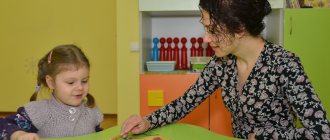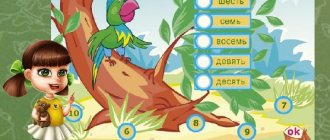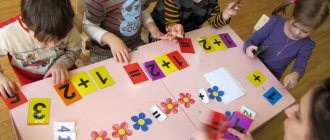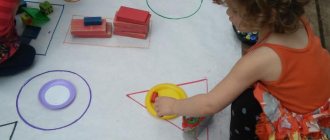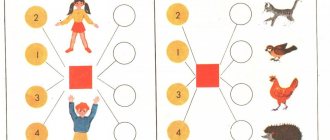Kurgan City Innovation and Methodology Center
Mathematics must then be taught, because it puts the mind in order!”
(M.V. Lomonosov)
In accordance with the Federal State Educational Standard, a preschool educational institution is the first level of education, and a kindergarten performs an important function of preparing children for school. And the success of his further education largely depends on how well and timely the child is prepared for school.
The development of elementary mathematical concepts is an extremely important part of the intellectual and personal development of a preschooler.
The problem of teaching children mathematics in modern life is becoming increasingly important. This is explained, first of all, by the rapid development of mathematical science and its penetration into various fields of knowledge. In this regard, the content of mathematics teaching in kindergarten is being systematically restructured.
The mastery of mathematical content by preschool children is a priority in the preschool education system due to its special significance in the cognitive development of the child, introducing him to active, purposeful, effective activities.
In this regard, I was interested in the problem: is it possible to increase the motivation of preschoolers in the formation of elementary mathematical concepts through the use of didactic games. Therefore, I chose for myself the topic of self-education “Development of mathematical abilities in preschool children through didactic games.”
Having carried out monitoring of children (the diagnostic material of which was selected in accordance with the criteria and age characteristics of the children), the results of which were at a low level, I came to the conclusion that the maximum effect of improving the quality of students’ mathematical education can be achieved through didactic games and entertaining exercises in educational activities in critical moments using the design method. Based on this, the idea came to create a project for children of the younger group with the active participation of parents (legal representatives) “Steps to Mathematics” using ICT resources.
Project type:
informative.
Project duration:
long-term (September 2022 to May 2018).
Objective of the project:
organization of work to develop the mathematical abilities of children in the junior group of kindergarten through didactic games in accordance with modern requirements.
Project objectives:
- Formation of elementary mathematical concepts in preschoolers through educational games;
- Development of communication abilities in children, readiness for joint activities with peers;
- Involving parents in the creation of a developing subject-spatial environment, taking into account the age and individual capabilities of the child.
Methods and means of project implementation:
- Productive activities (appliqué, drawing, sculpting)
- Game educational situations.
- Working with subject and subject pictures.
- Didactic games.
- Exercises to develop fine motor skills.
- Working with parents.
Contents of practical activities to implement the project:
- Carrying out monitoring of children according to FEMP
- Development of didactic material and didactic games.
- Development of methodological recommendations for parents.
Project participants:
- Children 3-4 years old
- Parents (legal representatives)
Expected results
are focused not only on the formation of mathematical ideas and concepts in children, but also on the development in children:
- high cognitive motivation;
- timely intellectual development of the child;
- high level of participation of parents in the life of the group, interest in the success of their child;
Project implementation stages
| Stages | The content of the work | Deadlines |
| Preparatory | Justification of the relevance of the topic, motivation for its choice, determination of the goals and objectives of the project, selection of literature, manuals, attributes, preparation of questionnaires for parents. | August 2017 |
| Basic | Carrying out planned forms of work. | September 2017- April 2018 |
| Final | Summarizing the results, work at the pedagogical council, diagnostics, presentation at the parent meeting. | May 2018 |
Project Implementation Plan
| Deadlines | Forms of work | Target |
| September 2017 | Questioning parents | Identifying the interests and knowledge of parents of pupils on issues of sensory development and education of preschool children |
| Monitoring of children using FEMP | ||
| October 2017 | Didactic game: "Merry little engine" | Introduce basic shapes, consolidate knowledge of geometric shapes |
| Parent meeting "We play and learn mathematics" | To contribute to the formation of parents' ideas about elementary mathematics in children of primary preschool age | |
| Game – activity “Alone. A lot of" | Name the number of objects, practice using words: “A lot. One" | |
| November 2017 | Seminar-workshop for parents “Child’s sensory development through non-traditional games” | Introduce parents to ways to form children's ideas about size, shape and color at home, using plastic bottles and colored caps |
| Didactic games: “Colorful buckets”, “Geometric panel” | Develop children's ideas about shape: teach to correlate quantities (one - many) | |
| Reading a poem S. Marshak “Fun Counting” | Analysis and discussion | |
| Application for kids "Sundress for Matryoshka" | Develop precision of movements, consolidate knowledge of the names of colors. | |
| December 2017 | Didactic games: “Geometric paths”, “Magic rug with snowflakes” | Getting to know the words “big”, “small”, “smaller” |
| Game-activity "Visiting fairy tales" | Continue to learn to distinguish the basic characteristics of objects - color, shape, height | |
| Didactic game: “Navigating in space” | Develop a dialogical form of speech | |
| January 2018 | Folder - moving "Math for kids in verse" | To help parents develop an understanding of elementary mathematics for children |
| Reading a mathematical fairy tale “Introduction to geometric figures, the first fairy tale, in which the sun compares a circle and a square” | Analysis and discussion | |
| Didactic games: “Wide - narrow”, “Big and small balls” | Learn to distinguish and compare objects according to different qualities of size. | |
| February 2018 | Game - activity "Leshy's Pranks" | Encourage children to name objects and their characteristics: shape, color, length, quantity |
| Didactic games: “Find your house”, “Find the same figure” | Strengthen children's ability to distinguish between circles, squares and triangles | |
| Artistic creativity "Fairytale houses" | Teach children to create the image of a fairy-tale house, conveying in the drawing the shape of familiar geometric shapes | |
| March 2018 | Working with parents: creation of a “game library” (didactic games for the development of elementary mathematical concepts in children) | To unite the efforts of the kindergarten and the family on the development of mathematical abilities in children of the group |
| Games - puzzles “Shapes”, “Studying geometric shapes” | Strengthen children's ability to distinguish between circles, squares and triangles | |
| Watching educational cartoons “Lessons from Aunt Owl - learning numbers” | Strengthen your knowledge of numbers. | |
| April 2018 | Educational nursery rhymes for kids | |
| Didactic game “What geometric shapes do these objects consist of? Color it" | Strengthen children's ability to distinguish circles, squares and triangles, color | |
| Showing pictures "Name the time of day" | ||
| Artistic creativity Modeling "Kolobok" | Strengthen children's ability to convey the shape of a circle in modeling | |
| May 2018 | Summarizing the results of work at the pedagogical council Monitoring Presentation of the results of the project at the parent meeting and the preschool educational institution website |
While working on the project, I noted that using these forms and methods showed that children:
- elementary mathematical concepts of this age group have been formed;
- children began to communicate more with each other and are ready for joint activities with peers;
- children's cognitive motivation increased;
- the quality of the mathematical education system for pupils in my age group has increased with the participation of the family (thanks to the efforts of the parents, they created a “toy library” for FEMP, constantly replenishing the developmental subject-spatial environment of the group);
I believe that the quality of mathematical education for preschool children in preschool educational institutions, with further continuous systematic work on the formation of sensory standards in children of primary preschool age using didactic games and materials, will be at a high level. In the future, I will also use the method of project technologies to develop the mathematical abilities of preschoolers.
Bibliography
- Veraksa N.E. From birth to school. Basic educational program of preschool education / Ed. NOT. Veraksy, T.S. Komarova, M. A. Vasilyeva. – 3rd ed., rev. and additional – M.: Mosaika-Sintez, 2015.
- Novikova V.P. – Mathematics in kindergarten. Junior preschool age. – M.: Mosaic – Synthesis, 2006. – 104 p.: ill.
- Pomoraeva I.A. “Formation of elementary mathematical concepts” junior group / I.A. Pomoraeva, V.A. Pozin publishing house Mozaika - Sintez, M., 2015.
- Tarabarina T.I. “Both study and play: mathematics: a popular guide for parents and teachers” / T.I. Tarabarina, N.V. Yolkina.
- https://doshkolnik.ru/matematika/10685-chislo-5.html
- https://nsportal.ru/detskiy-sad/matematika/2014/03/15/odin-mnogo
MAGAZINE Preschooler.RF
GENERALIZATION OF INNOVATIVE PEDAGOGICAL EXPERIENCE ON THE TOPIC: “Formation of elementary mathematical concepts through didactic games”1. Conditions for the emergence and formation of experience.
“Without play there is not and cannot be full-fledged mental development. A game is a huge bright window through which a life-giving stream of ideas and concepts flows into the child’s spiritual world. “Game is the spark that ignites the flame of inquisitiveness and inquisitiveness.” .
V.A. Sukhomlinsky.
I began my work as a kindergarten teacher in March 1999 at MKDOU kindergarten No. 2 of a general developmental type with priority implementation of activities in the physical direction of children's development. And very soon, from my teaching practice, I learned that one of the most interesting and exciting activities for my group students was mathematics.
The development of elementary mathematical concepts in preschoolers is a special area of cognition in which, subject to consistent training, it is possible to purposefully form abstract logical thinking and increase the intellectual level.
In preschool age, play is of utmost importance in a child’s life. The need for play in children continues and occupies a significant place even during the first years of their schooling. In games there is no real conditioning by circumstances, space, time. Children are the creators of the present and the future. This is the charm of the game. Mathematical concepts and skills are a kind of means and methods of cognition necessary for mastering the world and acting in it (determine the size; compare, select by size; make a purchase, etc.).
Their use in a variety of cognitive and practical situations (games, experimentation, physical, productive, speech, musical activities, etc.) shows their value and thereby creates motivation to master them.
In play, a child makes discoveries about things that have long been known to adults. Children do not set any other goals in the game than to play.
For children of preschool age, play is of exceptional importance: for them, play is study, work, and a serious form of education. Play for preschoolers is a way of learning about the world around them.
In the game, the child acquires new knowledge, skills and abilities. Games that promote the development of perception, attention, memory, thinking, and the development of creative abilities are aimed at the mental development of the preschooler as a whole.
Mathematics plays a huge role in mental education and in the development of intelligence. The practice of forming elementary mathematical concepts in preschoolers has shown that its success is influenced by the form of presentation of the material, which can arouse the interest of children. To do this, it is necessary to use such methods and techniques when knowledge is not given to children in a ready-made form, but is comprehended by them through independent analysis, comparison of essential features of objects and phenomena, and establishment of interdependencies.
Watching children work with didactic materials, I noticed that not all children do it well. One child needs a little help, while another requires a lot of teaching and training. The reasons here are cumulative: undeveloped skills and abilities, underdeveloped imagination, as well as attention and thinking. Undeveloped skills and abilities prevent the child from expressing thoughts and complicate the development of cognition and perception.
Imperfect methods of conducting any classes, including mathematics, can negatively affect the development of a child. A personality-oriented approach to raising children is the most current direction in pedagogical methods. In my opinion, we should offer children, and not impose, help children, and not force them. And to help a child find himself, we offer him as many different ways of self-expression as possible. Sooner or later, he will definitely choose his own path, which will allow him to fully show himself.
In order to improve the development of children’s elementary mathematical concepts, I set myself the goal of developing children’s thinking through didactic play.
2. Relevance and prospects of the experience.
For the mental development of children, their acquisition of mathematical concepts, which actively influence the formation of mental actions that are so necessary for understanding the world around them, is essential. All acquired knowledge and skills are consolidated in didactic games, which need to be given great attention.
Their main purpose is to provide children with knowledge in distinguishing, identifying, naming a variety of objects, numbers, geometric figures, directions. Didactic games have the opportunity to form new knowledge and introduce children to methods of action. Each game has a specific task of improving children’s mathematical (quantitative, spatial, temporal) concepts.
All acquired knowledge and skills prepare children for mastering more complex mathematical problems at the next stage of development. This means that by forming elementary mathematical concepts in preschoolers, we prepare the child to study mathematics at school.
In this regard, I was interested in the problem: is it possible to increase the motivation of preschoolers in the formation of elementary mathematical concepts through the use of didactic games.
3. The leading pedagogical idea of experience.
The leading pedagogical idea of the experience: identifying ways to increase the motivation of a preschooler in the formation of mathematical concepts through the use of didactic games.
The development of logical thinking is of particular importance for preparing children for school. After all, it is important not only what knowledge a child has by the time he enters school, but whether he is ready to acquire new knowledge, whether he can reason, fantasize, draw independent conclusions, and create ideas for essays, drawings, and designs. And the most effective method is the use of didactic (educational) games as one of the forms of an adult’s educational influence on a child and, at the same time, the main activity of preschoolers.
4. Theoretical basis of experience.
When developing a system of educational didactic games, I became acquainted with the theory and practice of didactic games by researchers such as A.P. Usova, P.A. Wenger, A.K. Bondarenko and this was the methodological basis of the work. A.V. Zaporozhets, A.P. Usova, N.Ya. Mikhailenko, N.A. Korotkova and others especially emphasize its general developmental nature, its influence on the development of intellectual, communicative, and special abilities. The effectiveness of using didactic games in the pedagogical process is determined by the competent correlation of didactic and educational tasks. Taking into account the child’s state of thinking and his latent capabilities, it is necessary to set tasks in didactic games that ensure the activation of all mental functions. Most studies (L.A. Wenger, O.M. Dyachenko, A.P. Usova) note the enormous educational potential of didactic games in sensory and intellectual development. And we should agree with this, since this type of games contributes to the formation of a number of mental processes (attention, perception, thinking, memory, speech) and mental operations (comparison, analysis, classification, generalization, synthesis).
Another domestic teacher A.P. Usova, assessing the didactic game and its role in the educational system, wrote: “Didactic games, game tasks and techniques make it possible to increase the sensitivity of children, diversify the child’s educational activities, and add entertainment . Researchers such as A.P. Usova, E.I. Radina, F.N. dealt with issues of the theory and practice of didactic games. Bleher, B.I. Khachapuridze, Z.M. Boguslavskaya, E.F. Ivanitskaya, A.I. Sorokina, E.I. Udaltsova, V.N. Avanesova, A.K. Bondarenko, L.N. Wenger.
In the book: “Didactic games in kindergarten” Sorokin A.I. gave a classification of didactic games according to educational content, cognitive activity of children, game actions and rules, organization and relationships of children, and the role of the teacher.
D.V. Mendzheritsky’s book: “To the Educator about Children’s Play” highlighted the following requirements for didactic games:
— Each didactic game should provide exercises useful for the mental development of children and their education.
— In a didactic game, there must be an exciting task, the solution of which requires mental effort and overcoming some difficulties. The didactic game, like any other, includes the words of A.S. Makarenko: “A game without effort, a game without active activity is always a bad game.”
— Didacticism in the game should be combined with entertainment, jokes, and humor. Passion for the game mobilizes mental activity and makes it easier to complete the task.
Thus, the formation of elementary mathematical concepts through didactic games is considered as a consequence of teaching mathematical knowledge.
5. Novelty of experience.
The novelty of this experience lies in the modernization of various gaming methods and forms when conducting direct educational activities in mathematics. Didactic games have the opportunity to form new knowledge, introduce children to methods of action, each of the games solves a specific didactic problem of improving children’s ideas.
6. Technology of experience.
Goal: formation of elementary mathematical concepts through didactic games.
Tasks:
- Establish personal contact with children in an atmosphere of business cooperation.
- Attract children's attention to completing game tasks.
- Develop the ability to construct simple statements about the essence of the action performed; find the right way to complete the task.
- To cultivate determination and perseverance in achieving goals through didactic games.
Working in kindergarten, I set a goal for myself: to develop children’s memory, attention, thinking, and imagination, since without these qualities the development of the child as a whole is unthinkable.
I noticed that children rarely answer questions, doubt their answers, and their attention and memory are poorly developed. She conducted a survey, with the help of which she was able to identify children who were especially in need of help. The children made mistakes in counting, could not navigate time, and many did not know geometric figures.
Then she drew up a long-term plan for didactic games on FEMP.
The first group of games included teaching children to count forward and backward.
Using a fairy tale plot, I introduce children to the formation of all numbers within 10 by comparing equal and unequal groups of objects. Two groups of objects are compared, located either on the lower or on the upper strip of the counting ruler. This is done so that children do not have the misconception that the larger number is always on the top band and the smaller number is always on the bottom. By playing such educational games as “Which number is missing?”, “How much?”, “Confusion?”, “Correct the mistake”, “Remove the numbers”, “Name the neighbors”, children learn to freely operate with numbers within 10 and accompany words your actions. Didactic games “Think of a number”, “Number what is your name?”, “Make a sign”, “Make a number”, “Who will be the first to name which toy is missing?” and many others are used in classes in their free time to develop children's attention, memory, and thinking.
Didactic games acquire particular importance in the formation and development of mathematical concepts in preschoolers, including quantitative ones. Learning quantitative relationships is a complex process, so it is not surprising that their assimilation causes significant difficulties in children. Very often children do not understand why they need to count and measure, and not approximately, but accurately.
The selection of didactic games for the formation and development of quantitative concepts is carried out in accordance with program requirements, taking into account the possibilities of children’s participation in the game and their interest in them. Games with more difficult mathematical tasks are preceded by games with tasks of lesser difficulty, serving as a preparation for their implementation.
Knowing that it is difficult for preschoolers to maintain interest in one type of activity for a long time, and, consequently, in one, even a very useful game, it is necessary to pay more attention to games with different options - the same game should be modified. This will remove difficulties in mastering the rules of the game and will maintain interest in the game already familiar to preschoolers for some time. For example, to consolidate knowledge of the composition of the first ten numbers, the game “What has changed?” . This game uses various teaching materials: first objects, then pictures, and finally number figures and cards with numbers.
The second group includes games for spatial orientation. Teach children to navigate in specially created spatial situations and determine their place according to a given condition. With the help of didactic games and exercises, children master the ability to determine in words the position of one or another object in relation to another. This arouses children's interest and organizes them for the activity. For example, the game: “Artists”
The presenter invites the children to draw a picture. Everyone thinks about its plot together: a city, a room or a zoo, etc. Then everyone talks about the intended element of the picture, explaining where it should be located in relation to other objects. The adult fills the picture with the elements suggested by the children, drawing it with chalk on a blackboard or a felt-tip pen on a large sheet of paper. In the center you can draw a hut, at the top on the roof of the house - a pipe. Smoke rises from the chimney, and a cat sits below in front of the hut. The following words can be used in the task: above, below, left, right, from behind, between, near, next to.
The third group includes games to consolidate knowledge about the shape of geometric shapes.
Children are invited to recognize the shape of a circle, triangle, and square in surrounding objects. For example, “What geometric shape does the bottom of a plate resemble?” (table top surface, sheet of paper, etc.). The Lotto game is being played. Children are offered pictures (3-4 pieces each), in which they look for a figure similar to the one being demonstrated.
The didactic game “Geometric Mosaic” can be used in classes and in free time in order to consolidate knowledge about geometric shapes, in order to develop attention and imagination in children. Before the game starts, children are divided into two teams according to the level of their skills. Teams are given tasks of varying difficulty. For example:
Compiling an image of an object from geometric shapes.
Work according to a ready-made sample.
Work according to the conditions (assemble a human figure, a girl in a dress).
Work according to one's own design (just a person's).
Each team receives the same sets of geometric shapes. Children independently agree on ways to complete the task and the order of work. Each player in the team takes turns participating in the transformation of the geometric figure, adding his own element, making up a separate element of the object from several figures. In conclusion, children analyze their figures, find similarities and differences in solving a constructive plan. The use of these didactic games helps to consolidate children's memory, attention, and thinking.
The fourth group is didactic games for the development of logical thinking. At preschool age, children begin to develop elements of logical thinking, i.e. The ability to reason and make your own conclusions is formed. There are many didactic games and exercises that influence the development of creative abilities in children, as they have an effect on the imagination and contribute to the development of non-standard thinking in children. These are games such as “Find a non-standard figure, how are they different?”, “Mill”, and others. They are aimed at training thinking when performing actions.
This is a task to find a missing figure, to continue a series of figures, signs, to find numbers. Getting acquainted with such games begins with elementary tasks on logical thinking - a chain of patterns. In such exercises there is an alternation of objects or geometric shapes. I invite the children to continue the series or find the missing element. In addition, I give tasks of the following nature: continue the chain, alternating squares, large and small circles of yellow and red in a certain sequence. After children learn to perform such exercises, the tasks become more difficult for them. I propose to complete a task in which you need to alternate objects, taking into account both color and size.
Any mathematical task involving ingenuity, no matter what age it is intended for, carries a certain mental load. Mathematical material is made more interesting by the game elements contained in each problem, logical exercise, and entertainment, be it checkers or the most basic puzzle.
The fifth group of mathematical games is time travel. Serves to introduce children to the days of the week. It is explained that each day of the week has its own name. In order for children to better remember the names of the days of the week, they are indicated by circles of different colors. I spend several weeks observing, marking each day with circles. In the future, you can use the following games “All Year Round”, “Twelve Months”, which help children quickly remember the names of the days of the week and the names of the months, their sequence. Children enjoy playing the game "Live Week" . To play, I call 7 children to the board, count them in order, and give them circles of different colors, indicating the days of the week. Children line up in the same order as the days of the week. For example, the first child with a yellow circle in his hands, indicating the first day of the week - Monday, etc.
Then children, starting from any other day of the week.
I also use entertaining tasks in poetic form.
When conducting mental calculations, exercises and tasks are included. This enlivens the work and introduces an element of entertainment.
- * *
A star fell from the sky and ran to visit the children. Two shout after her: “Don’t forget your friends!”
How many bright stars have disappeared, fallen from the starry sky?
- * *
The holiday is coming soon - New Year, Let's stand in a friendly round dance. Let's sing a loud song and congratulate everyone on this day.
Let's prepare gifts for everyone. This holiday is very bright. We will give Katya, Masha and Alenka a Burenka each,
And Andryusha and Vityusha - By car and by pear. Sasha will be happy with Parsley and a large colored firecracker.
Well, for Tanechka - Tanya - a brown bear in gray plush. You, friends, count the guests, call them by name.
An important condition for the effectiveness of teaching mathematics is the attention of children.
By listening carefully to the explanation, the child more easily perceives, understands, remembers the content of the material, and thereby facilitates his further work. Therefore, great importance is given to the education of voluntary attention in preschoolers. For this purpose, special exercises and tasks are constantly included in classes aimed at developing attention, developing activity, independence, and a creative attitude to business.
Here are a few tasks that help cultivate interest and attention in FEMP classes.
Game "Notice everything!" On a typesetting canvas I display 7-8 pictures in one row depicting objects (mushroom, ball, pyramid). Children are asked to look at object pictures (10 sec.). Then the object pictures are covered, and the children are asked to list them and name the sequence. Swap two or three pictures and ask what has changed on the typesetting canvas. Remove one of the pictures and ask which picture disappeared, ask to describe it.
Game "Notice everything!" You can carry out the same tasks, but replacing object pictures with geometric figures. Preschoolers are asked the following questions: What figures are depicted? How many are there? What color are they? In what order are they depicted? Ask each child to place these figures on the table, using individual counting material.
These tasks are used when comparing groups of objects, familiarization with the concept of “the same .
Game “What has changed? I put 3-7 toys in front of the children. I give a signal for them to close their eyes, and at this time I remove one toy. Having opened their eyes, children must guess which toy is hidden.
Game "Find the differences" . I show the guys two almost identical drawings and ask them to find how one drawing differs from the other.
Game “Find the same ones” . In the picture, children must find two identical objects.
Working with parents.
An important component of the work is working with parents.
The work began with the involvement of interested parents, and then the rest became involved. A significant part of the time was devoted to joint activities between parents and children.
A consultation was held for parents: “The role of didactic games in the formation of elementary mathematical concepts in preschool children .
“Development of mathematical abilities in preschoolers”.
Conducted a parent meeting on the topic: “Journey to the Land of Mathematics” , organized an exhibition of gaming materials and didactic games. I also conducted a workshop with parents on how to guide a didactic game. This work was beneficial and attracted their attention.
My parents took part in designing and replenishing the math corner in the group and helped me make didactic games. Thus, children’s play activities have become an active means of education and development not only in kindergarten, but also in the family.
In my work with parents I used the following forms:
- Thematic parent meeting.
- Consultations and conversations (individual and collective).
- Registration of written consultations in the parent corner.
- Joint development of the math corner in the group with parents.
- The effectiveness of the experience.
In preschool age, the foundations of the knowledge a child needs in school are laid. Both parents and teachers know that mathematics is a powerful factor in the intellectual development of a child, the formation of his cognitive and creative abilities. The most important thing is to instill in the child an interest in learning. To do this, direct educational activities must take place in a fun form.
Thanks to games, it is possible to concentrate the attention and attract the interest of even the most disorganized preschool children. At the beginning, they are captivated only by game actions, and then by what this or that game teaches. Gradually, children awaken interest in the subject of study itself.
Thus, in a playful way, instilling in a child knowledge in the field of mathematics will teach him to perform various actions, develop memory, thinking, and creative abilities. In the process of playing, children acquire complex mathematical concepts and learn to count, and in the development of these skills the child is helped by close people - his parents and teacher.
The main directions for improving pedagogical work are:
- widespread use of didactic, educational games in direct educational activities with children in the formation of elementary mathematical concepts
- consistency in the use of didactic games in the formation of elementary mathematical concepts in preschoolers
- active involvement of parents in the process of intellectual development of the child by increasing their pedagogical skills through interaction with the teacher.
Using various didactic games in working with children, I was convinced that when playing, children better absorb program material and correctly complete complex tasks. This is confirmed by diagnostics on the formation of elementary mathematical concepts. Diagnostic results have improved.
Therefore, I recommend that educators use didactic games in the process of teaching children.
With the help of developmental education, children will enter the world of mathematics through exciting games, and learning will not seem difficult and boring to them.
8. Targeting of experience.
This work experience is addressed to teachers of preschool educational institutions and parents; it reveals the formation of elementary mathematical concepts of children through didactic play with children from 3 to 6 years old, taking into account their psycho-physical development.
| Next > |

